 Guns are generally classified according to use, size, and tradition. This varies among the military
services. The basic distinction is between small arms and artillery. Any gun below a 20-
millimeter bore size is generally classified as a small arm. The Army distinguishes among mortars, howitzers, and guns. Mortars give high trajectories with
short range and are usually loaded from the muzzle. Howitzers give medium-to-high trajectories,
and guns provide flat-to-medium trajectories of longer range. Bore size is usually given in
millimeters.
A gun can be considered as a particular kind of heat engine. In operation, the propellant charge
located in the gun chamber is ignited by the primer. Gases produced by combustion of the
propellant grains cause a rapid buildup of pressure. When a certain pressure is reached (shot-start
pressure) which overcomes the forces of projectile weight and engraving of the projectile in
the rifling, the projectile begins to move toward the muzzle which causes an increase in chamber
volume. A maximum pressure is reached a few inches from the origin of rifling followed by a
decrease in pressure all the way to the muzzle. At the muzzle, the pressure is 10 percent to 30
percent of the maximum pressure, depending on the geometry of the propellant grains.
Guns are generally classified according to use, size, and tradition. This varies among the military
services. The basic distinction is between small arms and artillery. Any gun below a 20-
millimeter bore size is generally classified as a small arm. The Army distinguishes among mortars, howitzers, and guns. Mortars give high trajectories with
short range and are usually loaded from the muzzle. Howitzers give medium-to-high trajectories,
and guns provide flat-to-medium trajectories of longer range. Bore size is usually given in
millimeters.
A gun can be considered as a particular kind of heat engine. In operation, the propellant charge
located in the gun chamber is ignited by the primer. Gases produced by combustion of the
propellant grains cause a rapid buildup of pressure. When a certain pressure is reached (shot-start
pressure) which overcomes the forces of projectile weight and engraving of the projectile in
the rifling, the projectile begins to move toward the muzzle which causes an increase in chamber
volume. A maximum pressure is reached a few inches from the origin of rifling followed by a
decrease in pressure all the way to the muzzle. At the muzzle, the pressure is 10 percent to 30
percent of the maximum pressure, depending on the geometry of the propellant grains.
Artillery ammunition can be classified in many ways. One classification is based on the manner in which the components are assembled for loading and firing. Complete rounds of artillery ammunition are known as either semi-fixed or separate loading. In contrast, small arms rounds are FIXED ammunition, with which it is not possible to adjust the amount of propellant in the cartridge case).
Semi-fixed ammunition is characterized by an adjustable propelling charge. The propellant is divided into increments, or charges, and each increment of propellant is contained in a cloth bag. All of the cloth bags are held together by an acrylic cord, and are stored in the cartridge case. The primer is an integral part of the cartridge case, and is located on the base. Semi-fixed ammunition may be issued fuzed or unfuzed. Semi-fixed ammunition is used in 105mm howitzers. The ammunition is shipped in a wooden crate, with two fiber tubes in each crate. The fiber tubes are sealed at each end with tape. Upon removing the tape, the cannoneer will place the heavy end down first, and remove the projectile from the fiber tube. Next, the cartridge case is removed. Both the projectile and canister MUST REMAIN in their fiber cups until firing.
Separate loading ammunition has four separate components: primer, propellant, projectile, and fuze. The four components are issued separately. Upon preparation for firing, the projectile and propellant are loaded into the howitzer in two separate operations. Separate loading ammunition is used in 155mm howitzers.
There are two explosive trains in each conventional round of artillery ammunition; the PROPELLING CHARGE EXPLOSIVE TRAIN, and the PROJECTILE EXPLOSIVE TRAIN. The projectile reaches the target area by the power obtained from the propelling charge explosive train. The function of the projectile in the target area depends on the type of projectile explosive train.
The propelling charge explosive train consists of the primer, igniter, and propellant. The propelling charge explosive train is initiated by the primer, which is a small amount of very sensitive explosive. The primer is very sensitive to shock, friction, spark, and heat, and must be kept protected and away from other ammunition components. In separate loading ammunition, the primer is a separate item of issue. The igniter provides hot flaming gases and particles to ignite the propelling charge. The igniter consists of black powder or Clean Burning Igniter (CBI). The igniter is very hygroscopic and subject to rapid deterioration on absorption of moisture. If kept dry, however, it retains its explosive properties indefinitely. The igniter for semi-fixed ammunition is an integral part of the primer. It consists of a perforated tube filled with black powder and is permanently mounted in the cartridge case. In separate loading ammunition, the igniter is in a circular red pancake shaped bag sewn to the base increment of the propellant. When ignited by the primer, the igniter sends hot flaming gases around the charge to ignite the propellant.
A propellant is a large amount of insensitive but powerful explosive that propels the projectile to the target. Semi-fixed ammunition propellant is generally issued with seven increments numbered 1 through 7, and connected by a thin acrylic cord. Each increment is a different size because each increment has a different premeasured amount of propellant. Increment 1 and 2 are single perforated and increments 3-7 are multi-perforated. Separate loading ammunition propellants are issued as a separate unit of issue in sealed canisters to protect the propellant. The amount of propellant to be fired with artillery ammunition is varied by the number of propellant increments. The charge selected is based on the range to the target and the tactical situation.
Projectile Design
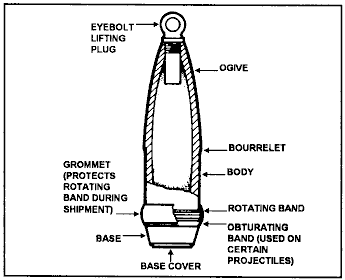
Since the first projectile was manufactured, the demand for greater accuracy and greater range has influenced projectile
design. Without specifically constructed shapes and exterior parts, there would be no standard ballistic characteristics for
any group or type of projectiles. A lack of ballistic standardization would prevent the computation of firing tables. Modern
projectiles are designed for maximum stability and minimum air resistance in flight.
Eyebolt Lifting Plugs and Fuze Well Plugs. A separate-loading projectile has an eyebolt lifting plug. Other types of projectiles have metal hex-head or plastic closing plugs. The plug is for lifting; to keep the fuze well clean, dry, and free of foreign matter; and to protect the fuze well threads. The plug is removed, and the appropriate fuze is inserted at the firing position. Some special-purpose semifixed projectiles are issued with the fuzes already assembled in the projectile.
Ogive. The ogive is the curved portion of a projectile between the fuze well and the bourrelet. It streamlines the forward portion of the projectile. The curve of the ogive usually is the arc of the circle, the center of which is located in a line perpendicular to the axis of the projectile and the radius of which is generally 6 to 11 calibers.
Bourrelet. The bourrelet is an accurately machined surface that is slightly larger than the body and located immediately to the rear of the ogive. It centers the forward part of the projectile in the tube and bears on the lands of the tube. When the projectile travels through the bore, only the bourrelet and the rotating band of the projectile bear on the lands of the tube.
Body. The body is the cylindrical portion of the projectile between the bourrelet and the rotating band. It is machined to a smaller diameter than the bourrelet to reduce the projectile surface in contact with the lands of the bore. The body contains most of the projectile filler.
Rotating Band. The rotating band is a cylindrical ring of comparatively soft metal that is pressed into a knurled, or roughened, groove near the base of the projectile. It mates with the forcing cone of the tube to eliminate gas wash (blow-by) and to provide forward obturation. The rotating band, in conjunction with the rifling of the tube, imparts spin to the moving projectile. A properly rammed separate-loading projectile is held in the tube at all angles of elevation by the wedging action of the rotating band against the forcing cone.
Obturating Band. On some projectiles, there is a nylon obturating band below the rotating band to help in forward obturation. Two examples of 155-mm projectiles with this type of a band are the illuminating round and the high-explosive rocket-assisted round.
Base. The base is that portion of the projectile below the rotating band or obturating band. The most common type is known as the boattail base. This type of base streamlines the base of the projectile, gives added stability in flight, and minimizes deceleration by reducing the vacuum-forming eddy currents in the wake of the projectile as it passes through the atmosphere.
Base Cover. The base cover is a metal cover that is crimped, caulked or welded to the base of the projectile. It prevents hot gases of the propelling charge from coming in contact with the explosive filler of the projectile through possible flaws in the metal of the base.
Large Caliber Ammunition - Types of Projectiles
Projectiles can be broadly classified according to three main types: spin-stabilized, fin-stabilized,
and rocket assisted (both fin- and spin-stabilized). Formal military classification is based on the
intended use of the projectile and the composition of the explosive charge (i.e., antipersonnel,
antitank, and incendiary). Some very significant progress in projectile design has been made in
the past few years.
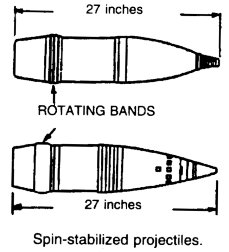 SPIN-STABILIZED PROJECTILES
Most guns in use today use spin-stabilized projectiles. Spinning a projectile promotes flight stability. Spinning is obtained by firing the projectiles through a rifled tube. The projectile engages the rifling by means of a rotating band normally made of copper. The rotating band is engaged by the lands and grooves. At a nominal muzzle velocity of 2800 feet per second, spin rates on the order of 250 revolutions per second are encountered. Spin-stabilized projectiles are full bore (flush with the bore walls) and are limited approximately
to a 5:1 length-to-diameter ratio. They perform very well at relatively low trajectories (less than 45� quadrant elevation). In high trajectory applications they tend to overstabilize (maintain the angle at which they were fired) and, therefore, do not follow the trajectory satisfactorily.
SPIN-STABILIZED PROJECTILES
Most guns in use today use spin-stabilized projectiles. Spinning a projectile promotes flight stability. Spinning is obtained by firing the projectiles through a rifled tube. The projectile engages the rifling by means of a rotating band normally made of copper. The rotating band is engaged by the lands and grooves. At a nominal muzzle velocity of 2800 feet per second, spin rates on the order of 250 revolutions per second are encountered. Spin-stabilized projectiles are full bore (flush with the bore walls) and are limited approximately
to a 5:1 length-to-diameter ratio. They perform very well at relatively low trajectories (less than 45� quadrant elevation). In high trajectory applications they tend to overstabilize (maintain the angle at which they were fired) and, therefore, do not follow the trajectory satisfactorily.
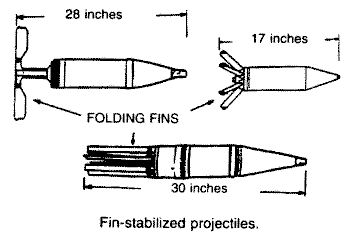 FIN-STABILIZED PROJECTILES These projectiles obtain stability through the use of fins located at the aft end of the projectile. Normally, four to six fins are employed. Additional stability is obtained by imparting some spin (approximately 20 revolutions/second) to the projectile by canting the leading edge of the fins.
Fin-stabilized projectiles are very often subcaliber. A sabot, wood or metal fitted around the projectile, is used to center the projectile in the bore and provide a gas seal. Such projectiles vary from 10:1 to 15:1 in length-to-diameter ratio. Fin-stabilized projectiles are advantageous because they follow the trajectory very well at high-launch angles, and they can be designed with very low drag thereby increasing range and/or terminal velocity. However, fin-stabilized projectiles are disadvantageous because the extra length of the projectile must be accommodated and the payload volume is comparatively low in relation to the projectile length.
ROCKET-ASSISTED PROJECTILES There are two main reasons for developing rocket-assisted projectiles: (1) to extend the range
over standard gun systems, and (2) to allow for lighter mount and barrel design and reduce excessive muzzle flash and smoke by reducing the recoil and setback forces of standard gun systems.
Since the ranges are different, the above two objectives represent opposite approaches in the development of rocket-assisted projectiles. Normally, one or the other establishes the performance of the rocket-assisted projectile under development although some compromise in
the two approaches may be established by the design objectives.
FIN-STABILIZED PROJECTILES These projectiles obtain stability through the use of fins located at the aft end of the projectile. Normally, four to six fins are employed. Additional stability is obtained by imparting some spin (approximately 20 revolutions/second) to the projectile by canting the leading edge of the fins.
Fin-stabilized projectiles are very often subcaliber. A sabot, wood or metal fitted around the projectile, is used to center the projectile in the bore and provide a gas seal. Such projectiles vary from 10:1 to 15:1 in length-to-diameter ratio. Fin-stabilized projectiles are advantageous because they follow the trajectory very well at high-launch angles, and they can be designed with very low drag thereby increasing range and/or terminal velocity. However, fin-stabilized projectiles are disadvantageous because the extra length of the projectile must be accommodated and the payload volume is comparatively low in relation to the projectile length.
ROCKET-ASSISTED PROJECTILES There are two main reasons for developing rocket-assisted projectiles: (1) to extend the range
over standard gun systems, and (2) to allow for lighter mount and barrel design and reduce excessive muzzle flash and smoke by reducing the recoil and setback forces of standard gun systems.
Since the ranges are different, the above two objectives represent opposite approaches in the development of rocket-assisted projectiles. Normally, one or the other establishes the performance of the rocket-assisted projectile under development although some compromise in
the two approaches may be established by the design objectives.
Large Caliber Ammunition - Types of Warhead
For convenience of discussion, large caliber ammunition may be be classified into five major groups: blast (including air and underwater burst), fragmentation, shaped charge, pyrotechnics, and cluster.
Blast
A blast warhead is one that is designed to achieve target damage primarily from blast effect. When a high explosive detonates, it is converted almost instantly into a gas at very high pressure and temperature. Under the pressure of the gases thus generated, the weapon case expands and breaks into fragments. The air surrounding the casing is compressed and a shock (blast) wave is transmitted into it. Typical initial
values for a high-explosive weapon are 200 kilobars of pressure (1 bar = 1 atmosphere) and 5,000 degrees celsius.
The energetic materials used by Department of Defense munitions produce an exothermic reaction defined either as a deflagration or a detonation. A deflagration is an exothermic reaction that propagates from the burning gases to the unreacted material by conduction, convection, and radiation. In this process, the combustion zone progresses through the material at a rate that is less than the velocity of sound in the unreacted material.
In contrast, a detonation is an exothermic reaction that is characterized by the presence of a shock wave in the material that establishes and maintains the reaction. A distinctive difference is that the reaction zone propagates at a rate greater than sound velocity in the unreacted material. Every material capable of detonating has a characteristic velocity that is under fixed conditions of composition, temperature, and density.
The violent release of energy from a detonation in a gaseous medium gives a sudden pressure increase in that medium. The pressure disturbance, termed the blast wave, is characterized by an almost instantaneous rise from the ambient pressure to a peak incident pressure (Pso). This pressure increase, or shock front, travels radially from the burst point with a diminishing velocity that always is in excess of the sonic velocity of the medium. Gas molecules making up the front move at lower velocities. This latter particle velocity is associated with a "dynamic pressure," or the pressure formed by the winds produced by the shock front.
As the shock front expands into increasingly larger volumes of the medium, the peak incident pressure at the
front decreases and the duration of the pressure increases. If the shock wave impinges on a rigid surface oriented at an angle to the direction of propagation of the wave, a reflected pressure is instantly developed on the surface and the pressure is raised to a value that exceeds the incident pressure. The reflected pressure is a function of the pressure in the incident wave and the angle formed between the rigid surface and the plane of the shock front.
When an explosion occurs within a structure, the peak pressure associated with the initial shock front will be extremely high and, in turn, will be amplified by reflections within the structure. In addition, the accumulation of gases from the explosion will exert additional pressures and increase the load duration within the structure. The combined effects of both pressures eventually may destroy the structure if it is not strengthened sufficiently or adequate venting for the gas and the shock pressure is not provided, or both. For structures that have one or more strengthened walls, venting for relief of excessive gas or shock pressures, or both, may be provided by means of openings in or frangible construction of the remaining walls or roof, or both. This type of construction will permit the blast wave from an internal explosion to spill over onto the exterior ground surface. These pressures, referred to as exterior or leakage pressures,
once released from their confinement, expand radially and act on structures or persons, or both, on the other side of the barrier.
Conventional structures are designed to withstand roof snow loads of 30 pounds per square foot (1.44 kilopascals) and wind loads of 100 miles per hour (161 kilometers per hour). The loads equate to 0.2 pounds per square inch (psi).
An important consideration in the analysis of explosions is the effect of the fragments generated by the explosion. These fragments are known as primary or secondary fragments depending on their origin. Primary fragments are formed as a result of the shattering of the casing of conventional munitions. These fragments usually are small in size
and travel initially at velocities of the order of thousands of feet per second. Secondary fragments are formed as a result of high blast pressures on structural components and items in close proximity to the explosion. These fragments are somewhat larger in size than primary fragments and travel initially at velocities in the order of hundreds of feet per second. A hazardous fragment is one having an impact energy of 58 ft-lb (79 joules) or greater.
Fragmentation
The study of ballistics, the science of the motion of projec-tiles, has contributed significantly to the design of fragmentation warheads. Specifically, terminal ballistics studies attempt to determine the laws and conditions governing the velocity and distribution of fragments, the sizes and shapes that result from bursting different containers, and the damage aspects of the bursting charge fragmentation.
Approximately 30% of the energy released by the explosive detonation is used to fragment the case and
impart kinetic energy to the fragments. The balance of available energy is used to create a shock front
and blast effects. The fragments are propelled at high velocity, and after a short distance they overtake
and pass through the shock wave. The rate at which the velocity of the shock front accompanying the
blast decreases is generally much greater than the decrease in velocity of fragments, which occurs due to
air friction. Therefore, the advance of the shock front lags behind that of the fragments. The radius of
effective fragment damage, although target dependent, thus exceeds consid-erably the radius of effective
blast damage in an air burst.
Whereas the effects of an idealized blast payload are attenuated by a factor roughly equal to 1/R3 (R is
measured from the origin), the attenuation of idealized fragmentation effects will vary as 1/R2 and 1/R,
depending upon the specific design of the payload. Herein lies the principle advantage of a fragment-ation
payload: it can afford a greater miss distance and still remain effective because its attenuation is less.
Anti-personnel fragmentation munitions are designed to destroy or maim personnel or to damage material enough to render it inoperable. In the area of field artillery, the flechette or beehive round is an example of an anti-personnel warhead. The payload in this projectile consists of 8,000 steel-wire, fin-stabilized darts. Upon detonation the darts, or flechettes, are sprayed radially from the point of detonation, normally within sixty feet of the ground. It is extremely effective against personnel in
the open or in dense foliage.
Shaped Charge
The discovery of what is variously referred to as the shaped charge effect, the hollow charge effect, the
cavity effect, or the Munroe effect, dates back to the 1880s in this country. Dr. Charles Munroe, while
working at the Naval Torpedo Station at Newport, Rhode Island, in the 1880s, discovered that if a
block of guncotton with letters countersunk into its surface was det-onated with its lettered surface
against a steel plate, the let-ters were indented into the surface of the steel. The essential features of this
effect were also observed in about 1880 in both Germany and Norway, although no great use was made
of it, and it was temporarily forgotten.
A shaped charge warhead consists basically of a hollow liner of metal material, usually copper or
aluminum of conical, hemispherical, or other shape, backed on the convex side by explosive. A
container, fuze, and detonating device are included.
When this warhead strikes a target, the fuze detonates the charge from the rear. A detonation wave
sweeps forward and begins to collapse the metal cone liner at its apex. The collapse of the cone results
in the formation and ejection of a continuous high-velocity molten jet of liner material. Velocity of the tip
of the jet is on order of 8,500 meters per sec, while the trail-ing end of the jet has a velocity on the order
of 1,500 meters per sec. This produces a velocity gradient that tends to stretch out or lengthen the jet.
The jet is then followed by a slug that consists of about 80% of the liner mass. The slug has a velocity on
the order of 600 meters per sec.
When the jet strikes a target of armor plate or mild steel, pressures in the range of hundreds of kilobars are produced at the point of contact. This pressure produces stresses far above the yield strength of steel, and the target material flows like a fluid out of the path of the jet. This phenomenon is called
hydrodynamic penetration. There is so much radial momentum associated with the flow that the difference in diameter between the jet and the hole it produces depends on the characteristics of the target material. A larger diameter hole will be made in mild steel than in armor plate because the density and hardness of armor plate is greater. The depth of penetration into a very thick slab of mild steel will
also be greater than that into homogeneous armor.
In general, the depth of penetration depends upon five factors:
- Length of jet
- Density of the target material
- Hardness of target material
- Density of the jet
- Jet precision (straight vs. divergent)
The longer the jet, the greater the depth of penetration. Therefore, the greater the standoff
distance (distance from target to base of cone) the better. This is true up to the point at which the
jet particulates or breaks up (at 6 to 8 cone diameters from the cone base). Particulation is a
result of the velocity gradient in the jet, which stretches it out until it breaks up.
Jet precision refers to the straightness of the jet. If the jet is formed with some oscillation or wavy
motion, then depth of penetration will be reduced. This is a function of the quality of the liner and
the initial detonation location accuracy. The effectiveness of shaped charge warheads is reduced
when they are caused to rotate. Spin-stabilized projectiles generally cannot use shaped-charge
warheads.
Pyrotechnics
Pyrotechnics are typically employed for signaling, illuminating, or marking targets.
- Illumination--These warheads usually contain a flare or magnesium flare candle as the payload, which is expelled by a small charge and is parachuted to the ground. During its descent the flare is kindled. The illuminating warhead is thus of great usefulness during night attacks in pointing out enemy fortifications. Because these flares are difficult to extinguish if accidentally ignited, extreme caution in their
handling is required.
- Smoke--These munitions are used primarily to screen troop movements and play a vital role in battlefield tactics. A black powder charge ignites and expels canisters that may be designed to emit white, yellow, red, green, or violet smoke.
- Markers--White phosphorus is commonly employed as a pay-load to mark the position of the
enemy. It can be very dangerous, especially in heavy concentrations. The material can self-ignite in air,
cannot be extinguished by water, and will rekindle upon subsequent exposure to air. Body contact can
produce serious burns. Copper sulphate prevents its re-ignition.
Cluster
Cluster munitions are canisters containing dozens or hundreds of small bomblets for use against a variety of targets, such as personnel, armored ve-hicles, or ships. Once in the air, the canisters open, spreading the bomblets out in a wide pattern. The advantage of
this type of warhead is that it gives a wide area of coverage, which allows for a greater margin of error in delivery.
Flechettes
Flechettes are fin stabilized steel projectiles similar in appearance to arrows. During the Korean War the Chinese army tactic of human wave attacks against US lines of defence prompted interest in flechette projectiles in single and multiple projectile systems for small arms and antipersonnel (APERS) use. Flechettes have a performance criteria very different from the conventional rifle bullet. Typical modern flechettes are small light weight steel projectiles, and the velocity lost to air resistance is generally 375 fps. per 100 Meters of flight. Unlike rifle bullets, flechettes are not spin stabilized, but use fins to achieve level flight. The flechette's long body looses rigidity on target impact and bends into a hook, often breaking off the fin portion creating an additional wound. Flechette munitions include projectiles for use in the M16 rifle, CAWS (close assault weapons system), and 12 gage shotgun, as well as the 105mm M101A1/M102 howitzer, 2.75 in. FFAR (folding fin aircraft rocket), and the 70mm Hydra-70 FFAR.
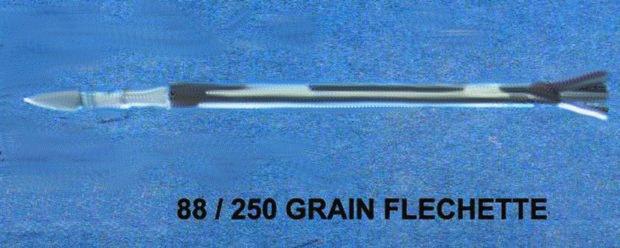
Painting and marking
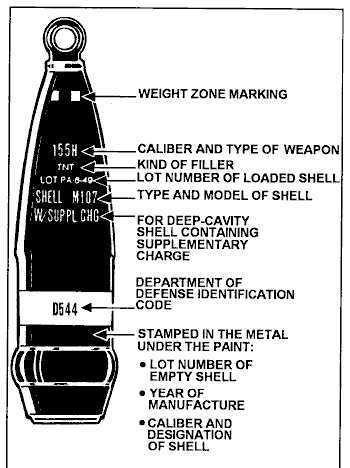 All projectiles are painted, both as a means of ready identification and as a rust preventative. The basic colors used for many years were olive drab (OD) for high-explosive rounds, gray for chemical rounds, blue for practice rounds, and black for drill rounds. A system of contrasting color markings or bands in addition to
the basic color has also been used to identify the particular type of high explosive or chemical used as a filler. Color coding of recently produced projectiles is somewhat different. For example, illuminating and smoke rounds are no longer painted gray, the basic color for chemical shells. Illuminating rounds are now painted basically white or olive drab, and the smoke rounds are painted green. The basic color for dummy ammunition has been changed to bronze.
Projectiles containing high explosive TNT Amatol, etc.) are painted yellow.
Projectiles containing chemicals (gas or smoke) are painted blue-gray.
Projectiles containing low explosives (black powder) are painted red.
Projectiles are also stenciled to show the caliber, type of cannon used in, ammunition lot number, kind of
filling, etc.
All projectiles are painted, both as a means of ready identification and as a rust preventative. The basic colors used for many years were olive drab (OD) for high-explosive rounds, gray for chemical rounds, blue for practice rounds, and black for drill rounds. A system of contrasting color markings or bands in addition to
the basic color has also been used to identify the particular type of high explosive or chemical used as a filler. Color coding of recently produced projectiles is somewhat different. For example, illuminating and smoke rounds are no longer painted gray, the basic color for chemical shells. Illuminating rounds are now painted basically white or olive drab, and the smoke rounds are painted green. The basic color for dummy ammunition has been changed to bronze.
Projectiles containing high explosive TNT Amatol, etc.) are painted yellow.
Projectiles containing chemicals (gas or smoke) are painted blue-gray.
Projectiles containing low explosives (black powder) are painted red.
Projectiles are also stenciled to show the caliber, type of cannon used in, ammunition lot number, kind of
filling, etc.
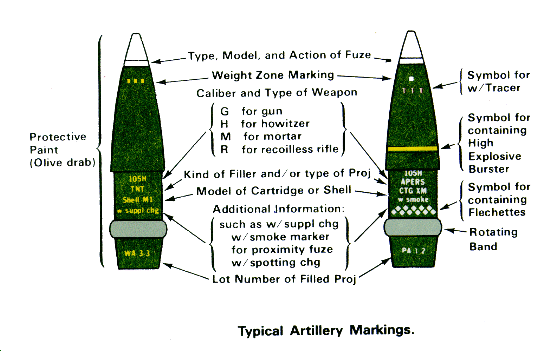

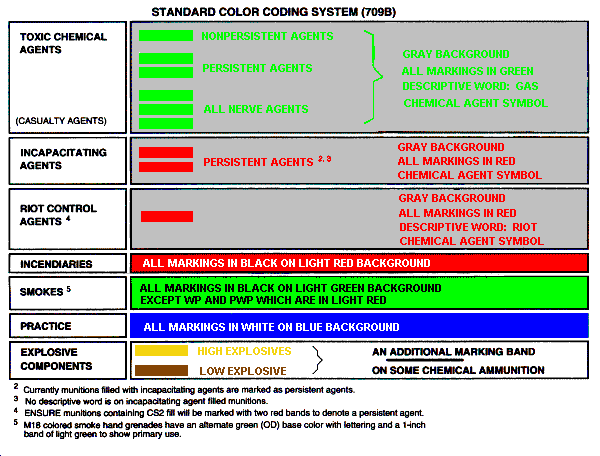
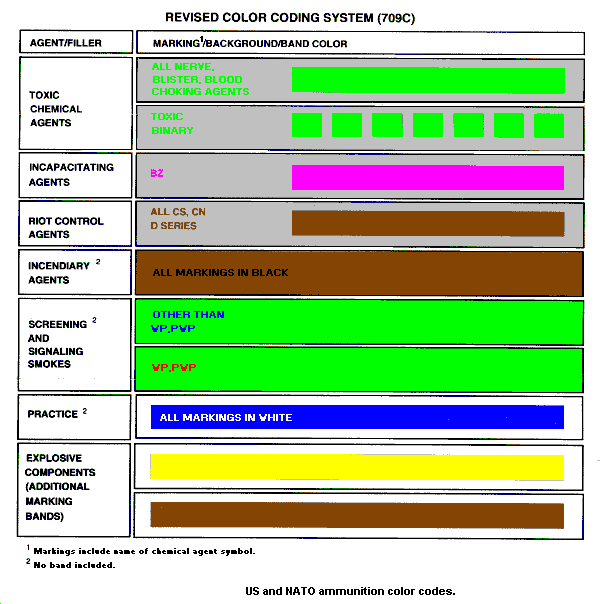
 Guns are generally classified according to use, size, and tradition. This varies among the military
services. The basic distinction is between small arms and artillery. Any gun below a 20-
millimeter bore size is generally classified as a small arm. The Army distinguishes among mortars, howitzers, and guns. Mortars give high trajectories with
short range and are usually loaded from the muzzle. Howitzers give medium-to-high trajectories,
and guns provide flat-to-medium trajectories of longer range. Bore size is usually given in
millimeters.
A gun can be considered as a particular kind of heat engine. In operation, the propellant charge
located in the gun chamber is ignited by the primer. Gases produced by combustion of the
propellant grains cause a rapid buildup of pressure. When a certain pressure is reached (shot-start
pressure) which overcomes the forces of projectile weight and engraving of the projectile in
the rifling, the projectile begins to move toward the muzzle which causes an increase in chamber
volume. A maximum pressure is reached a few inches from the origin of rifling followed by a
decrease in pressure all the way to the muzzle. At the muzzle, the pressure is 10 percent to 30
percent of the maximum pressure, depending on the geometry of the propellant grains.
Guns are generally classified according to use, size, and tradition. This varies among the military
services. The basic distinction is between small arms and artillery. Any gun below a 20-
millimeter bore size is generally classified as a small arm. The Army distinguishes among mortars, howitzers, and guns. Mortars give high trajectories with
short range and are usually loaded from the muzzle. Howitzers give medium-to-high trajectories,
and guns provide flat-to-medium trajectories of longer range. Bore size is usually given in
millimeters.
A gun can be considered as a particular kind of heat engine. In operation, the propellant charge
located in the gun chamber is ignited by the primer. Gases produced by combustion of the
propellant grains cause a rapid buildup of pressure. When a certain pressure is reached (shot-start
pressure) which overcomes the forces of projectile weight and engraving of the projectile in
the rifling, the projectile begins to move toward the muzzle which causes an increase in chamber
volume. A maximum pressure is reached a few inches from the origin of rifling followed by a
decrease in pressure all the way to the muzzle. At the muzzle, the pressure is 10 percent to 30
percent of the maximum pressure, depending on the geometry of the propellant grains.





 SPIN-STABILIZED PROJECTILES
Most guns in use today use spin-stabilized projectiles. Spinning a projectile promotes flight stability. Spinning is obtained by firing the projectiles through a rifled tube. The projectile engages the rifling by means of a rotating band normally made of copper. The rotating band is engaged by the lands and grooves. At a nominal muzzle velocity of 2800 feet per second, spin rates on the order of 250 revolutions per second are encountered. Spin-stabilized projectiles are full bore (flush with the bore walls) and are limited approximately
to a 5:1 length-to-diameter ratio. They perform very well at relatively low trajectories (less than 45� quadrant elevation). In high trajectory applications they tend to overstabilize (maintain the angle at which they were fired) and, therefore, do not follow the trajectory satisfactorily.
SPIN-STABILIZED PROJECTILES
Most guns in use today use spin-stabilized projectiles. Spinning a projectile promotes flight stability. Spinning is obtained by firing the projectiles through a rifled tube. The projectile engages the rifling by means of a rotating band normally made of copper. The rotating band is engaged by the lands and grooves. At a nominal muzzle velocity of 2800 feet per second, spin rates on the order of 250 revolutions per second are encountered. Spin-stabilized projectiles are full bore (flush with the bore walls) and are limited approximately
to a 5:1 length-to-diameter ratio. They perform very well at relatively low trajectories (less than 45� quadrant elevation). In high trajectory applications they tend to overstabilize (maintain the angle at which they were fired) and, therefore, do not follow the trajectory satisfactorily.
 FIN-STABILIZED PROJECTILES These projectiles obtain stability through the use of fins located at the aft end of the projectile. Normally, four to six fins are employed. Additional stability is obtained by imparting some spin (approximately 20 revolutions/second) to the projectile by canting the leading edge of the fins.
Fin-stabilized projectiles are very often subcaliber. A sabot, wood or metal fitted around the projectile, is used to center the projectile in the bore and provide a gas seal. Such projectiles vary from 10:1 to 15:1 in length-to-diameter ratio. Fin-stabilized projectiles are advantageous because they follow the trajectory very well at high-launch angles, and they can be designed with very low drag thereby increasing range and/or terminal velocity. However, fin-stabilized projectiles are disadvantageous because the extra length of the projectile must be accommodated and the payload volume is comparatively low in relation to the projectile length.
ROCKET-ASSISTED PROJECTILES There are two main reasons for developing rocket-assisted projectiles: (1) to extend the range
over standard gun systems, and (2) to allow for lighter mount and barrel design and reduce excessive muzzle flash and smoke by reducing the recoil and setback forces of standard gun systems.
Since the ranges are different, the above two objectives represent opposite approaches in the development of rocket-assisted projectiles. Normally, one or the other establishes the performance of the rocket-assisted projectile under development although some compromise in
the two approaches may be established by the design objectives.
FIN-STABILIZED PROJECTILES These projectiles obtain stability through the use of fins located at the aft end of the projectile. Normally, four to six fins are employed. Additional stability is obtained by imparting some spin (approximately 20 revolutions/second) to the projectile by canting the leading edge of the fins.
Fin-stabilized projectiles are very often subcaliber. A sabot, wood or metal fitted around the projectile, is used to center the projectile in the bore and provide a gas seal. Such projectiles vary from 10:1 to 15:1 in length-to-diameter ratio. Fin-stabilized projectiles are advantageous because they follow the trajectory very well at high-launch angles, and they can be designed with very low drag thereby increasing range and/or terminal velocity. However, fin-stabilized projectiles are disadvantageous because the extra length of the projectile must be accommodated and the payload volume is comparatively low in relation to the projectile length.
ROCKET-ASSISTED PROJECTILES There are two main reasons for developing rocket-assisted projectiles: (1) to extend the range
over standard gun systems, and (2) to allow for lighter mount and barrel design and reduce excessive muzzle flash and smoke by reducing the recoil and setback forces of standard gun systems.
Since the ranges are different, the above two objectives represent opposite approaches in the development of rocket-assisted projectiles. Normally, one or the other establishes the performance of the rocket-assisted projectile under development although some compromise in
the two approaches may be established by the design objectives.

 All projectiles are painted, both as a means of ready identification and as a rust preventative. The basic colors used for many years were olive drab (OD) for high-explosive rounds, gray for chemical rounds, blue for practice rounds, and black for drill rounds. A system of contrasting color markings or bands in addition to
the basic color has also been used to identify the particular type of high explosive or chemical used as a filler. Color coding of recently produced projectiles is somewhat different. For example, illuminating and smoke rounds are no longer painted gray, the basic color for chemical shells. Illuminating rounds are now painted basically white or olive drab, and the smoke rounds are painted green. The basic color for dummy ammunition has been changed to bronze.
Projectiles containing high explosive TNT Amatol, etc.) are painted yellow.
Projectiles containing chemicals (gas or smoke) are painted blue-gray.
Projectiles containing low explosives (black powder) are painted red.
Projectiles are also stenciled to show the caliber, type of cannon used in, ammunition lot number, kind of
filling, etc.
All projectiles are painted, both as a means of ready identification and as a rust preventative. The basic colors used for many years were olive drab (OD) for high-explosive rounds, gray for chemical rounds, blue for practice rounds, and black for drill rounds. A system of contrasting color markings or bands in addition to
the basic color has also been used to identify the particular type of high explosive or chemical used as a filler. Color coding of recently produced projectiles is somewhat different. For example, illuminating and smoke rounds are no longer painted gray, the basic color for chemical shells. Illuminating rounds are now painted basically white or olive drab, and the smoke rounds are painted green. The basic color for dummy ammunition has been changed to bronze.
Projectiles containing high explosive TNT Amatol, etc.) are painted yellow.
Projectiles containing chemicals (gas or smoke) are painted blue-gray.
Projectiles containing low explosives (black powder) are painted red.
Projectiles are also stenciled to show the caliber, type of cannon used in, ammunition lot number, kind of
filling, etc.



